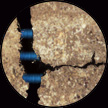

Codex of the Synapse: Folio C6.1
The Synaptic Fugue: Recursion and Self-Similarity
For between existing things there are always others still. Thus existing things must be infinite. ~ Zeno
"So, you're a private detective," she said. "I didn't know they existed, except in books." ~ Raymond Chandler, The Big Sleep
Repetition - as in tiles on an endless floor, or of integers plodding their way by measured increments, to oblivion - is an infinity with which we feel oddly secure, because it is so far away. By contrast, the infinity formed by recursion - the spiral of the Nautilus shell, the fractioned vastness between 1 and 2 - inspires disorientation and terror. Unlike the infinity of repetition, it is very close, lying in the interstices of every step we take, and every second that passes. We realize, suddenly, how tenuous our grasp on the finite really is.
It is this species of infinity - this Russian Matrioshka-doll of hierarchical regression - that forms the geometry of the Synapse. Recursions appear in the dreams the Keepers relate to describe the Synapse, in the Moments of Unreality that constitute the Synapse experience, in the Pattern Language Script, and in the structure of the Pattern Language itself.
Because the Synapse penetrates every lattice in the Continuum, every world has access to the Synapse. But is it the same Synapse for all of them? The Keepers never specify a single Synapse with many doors, shared in common by all the worlds. Rather, they imagine entering a neighbor-world through the Synapse, and wandering in it until a second Synapse is found, leading to yet further worlds, in which each world encloses its own synapse, which encloses yet further worlds, and so on. As inconceivable as this seems, The Keepers remind us that the Synapse is predicated on nothingness, and all structures made from nothingness, whether they are simple monoliths or Gothic Cathedrals, are, at their core, the same. All numbers multiplied by zero equal zero.
ADJOINING FOLIOS: